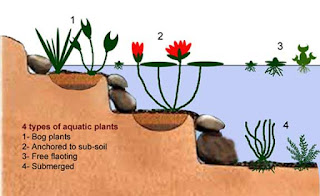(b) Anchored to sub-soil plants (c) Free floating plants. (d) Submersed plants.
Bog plants are those which grow in soil but need stagnant water near their roots all the time. Example: Acorus calamus (वेखंड), Cyperus alternifolius (Umbrella palm) and Typha angusta (रामबाण).
 |
| Acorus calamus |
 |
| Cypers alternifolius |
 |
| Cyperus prolifer |
 |
| Limnocharis flava |
 |
| Sagittaria montevidensis |
 |
| Sagittaria sagittifolia |
Anchored to sub-soil plants are those of which roots are submersed in water but leaves/flowers grow on surface of water or outside water. Examples: Water lily, Lotus.
 |
| Nymphaea species |
Free floating plants remain floating in water and can float away along with flowing water. Examples: Pistia stratiotes (Water cabbage), Lemna minor (Duck weed), Salvinia auriculata (Water ferns), Ludwigia sidioides (Water mosaic) and Azolla pinnata.
 |
| Water cabbage |
 |
| Duck weed |
 |
| Water mosaic |
 |
| Cabomba |
 |
| Vallisneria spiralis |
 |
| Hydrilla verticillata |





















